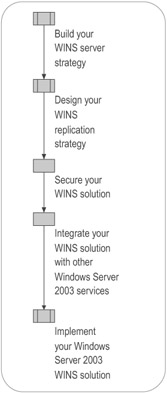Overview of WINS Deployment
WINS provides a dynamic solution for network basic input/output system (NetBIOS) name resolution in enterprise networks. Although most large networks currently have a WINS infrastructure, some still rely on other methods of NetBIOS name resolution, such as the Lmhosts file. If your organization does not currently use WINS, and intends to continue operating with Microsoft Windows 95, Windows 98, Windows Millennium Edition, or Microsoft Windows NT version 4.0, consider implementing WINS when you deploy Windows Server 2003 in order to automate NetBIOS name resolution. Certain applications, such as Microsoft Exchange Server, also rely on NetBIOS name resolution. Therefore, even if all of your computers are running Microsoft Windows 2000, Windows XP, or Windows Server 2003, you might still require NetBIOS name resolution based on the applications running in your environment.
If you are upgrading your current WINS servers to Windows Server 2003, determine if your existing hardware is compatible with Windows Server 2003, then migrate your WINS solution to Windows Server 2003.
By deploying WINS, you provide NetBIOS name resolution for clients on your network. WINS implements a distributed database for NetBIOS names and their corresponding addresses. WINS clients register their names at a local WINS server, and the WINS servers replicate the entries to the other WINS servers. This ensures the uniqueness of NetBIOS names and makes local name resolution possible.
WINS Deployment Process
Deploying WINS involves building a server strategy, designing a replication strategy, securing your WINS solution, integrating WINS with other services, and implementing your WINS solution. Figure 4.1 shows the general WINS deployment process.

Figure 4.1: Deploying WINS
Technology Background
Smaller, non-routed networks can be configured as broadcast nodes, also known as B-nodes, accomplishing NetBIOS name registration and resolution by using broadcast packets. A non-WINS solution is viable where the broadcast domain is small and the resulting broadcast traffic is low. However, the traffic generated by broadcasts can overload a large network. In addition, some routers do not allow broadcast messages to pass through, so this method of name resolution is not an option for most enterprise networks. Although you can also use the static Lmhosts file for NetBIOS name resolution, manually editing the file with each name or IP address change can be time-consuming and prone to administrative error. Also, it is not a viable solution in a Dynamic Host Configuration Protocol (DHCP) environment. These more complex environments require a non-broadcast-based solution, which WINS provides by using unicast NetBIOS name registration and resolution.
WINS client support allows you to specify up to 12 WINS servers for redundancy. Different configurations, or node types, are available through WINS. The node type determines the method or methods that are used for NetBIOS name resolution. WINS supports the following node types, as shown in Table 4.1.
| Node Type | Resolution Method |
|---|---|
| B-node | IP broadcast messages register and resolve NetBIOS names to IP addresses. Windows 2000-based and Microsoft Windows XP-based computers use modified B-node name resolution. If the broadcast fails to resolve the name, an Imhosts file is used. |
| P-node | Point-to-point communication with a NetBIOS name server, such as WINS, to register and resolve computer names to IP addresses. |
| M-node | A mix of B-node and P-node communication to register and resolve NetBIOS names. M-node first uses broadcast resolution, and then attempts a server query if necessary. |
| H-node | A hybrid of B-node and P-node. An H-node computer attempts to query a server first and uses broadcasts only if direct queries fail. Windows 2000 and Windows XP-based computers are configured to use H-node by default. |
New Features for Windows Server 2003
The following improvements to the Windows Internet Name Service (WINS) have been made in the Windows Server 2003 family:
Filtering records
Improved filtering and new search functions help you locate records by showing only those records that fit the criteria you specify. These functions are particularly useful in analyzing very large WINS databases. You can use multiple criteria to perform advanced searches for WINS database records. This improved filtering capability allows you to combine filters for customized and precise query results. Available filters include: record owner, record type, NetBIOS name, and IP address with or without subnet mask.
Because you can now store query results in the cache of the memory on your local computer, the performance of subsequent queries is increased, and network traffic is reduced.
Accepting replication partners
When determining a replication strategy for your organization, you can define a list that controls the source of incoming name records during pull replication between WINS servers. In addition to blocking name records from specific replication partners, you can also choose to accept only name records owned by specific WINS servers during replication, excluding the name records of all servers that are not on the list.
EAN: N/A
Pages: 146